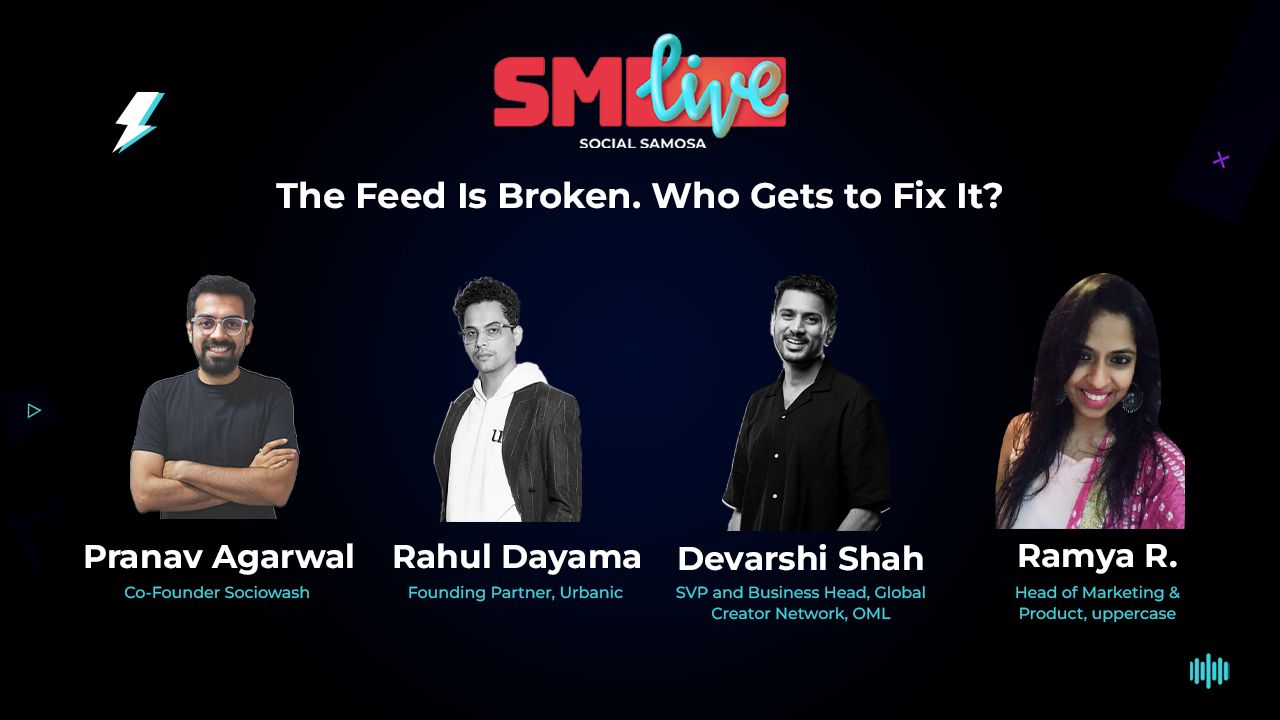The feed isn’t broken, it’s evolving

On World Social Media Day, SMLive's panel discussion, "The Feed Is Broken. Who Gets to Fix It?" brought together leading industry voices to dissect the current state of our social media experience. Moderated by Mrinil Mathur Rajwani, the session featured Pranav Agarwal, Co-Founder of Sociowash; Rahul Dayama, Founding Partner at Urbanic; Devarshi Shah, SVP and Business Head at OML's Global Creator Network; and Ramya R., Head of Marketing at uppercase.
The conversation quickly moved past the provocative title, with a consensus forming not around a "broken" feed, but one that is in a constant, and often chaotic, state of evolution.
Broken or just evolving?
The panelists unanimously agreed that the social media landscape hasn't broken, but has fundamentally transformed. Pranav Agarwal set the tone by making a case for an evolving feed, a thought echoed by Rahul Dayama, who added, “Sometimes you need the feed to break. That’s when something new gets through.”
Devarshi Shah questioned the very premise of the session, reflecting on his initial reaction to the topic. “When I first heard the topic, I genuinely thought, what do you mean the feed is broken? What even is broken?” he asked. “The platforms are evolving, just like we are... It’s not broken, it’s just different now.”
Ramya R. offered a nuanced perspective, acknowledging the challenges of the current ecosystem. “I wouldn’t call the feed broken, it’s evolving. What worked two years ago doesn’t work now,” she stated. Ramya pointed out that while platforms like YouTube are seeing deeper content consumption, "Instagram still leans on memes and cringe," suggesting that while the system isn't broken, "changes are definitely due."
Who controls the feed?
With the idea of an "evolving" feed established, the discussion shifted to the crucial question of control. Who truly shapes our online experience—platforms, creators, or the audience?
Devarshi Shah argued that control is multifaceted and ultimately still resides with the user. “The platform nudges you on format, but the audience decides what to engage with," he explained. "Just two weeks ago, I started a new Instagram account because my old one felt too hectic. That choice still lies with us.”
Ramya R. presented a compelling counterargument, suggesting the feeling of control is an illusion crafted by platforms. “Platforms make us think we have the power, but really we only choose from what we’re shown. That’s how we end up stuck in an endless loop,” she said. Comparing the experience to Spotify’s useful recommendations, she noted, “Instagram’s discovery often feels confusing and repetitive.”
Pranav Agarwal broke down the ecosystem into three key players: audiences, creators, and brands. He explained that while algorithms can be influenced, most users lack the know-how. “If you understand the algorithm, you can influence your own feed. But most people don’t know how it works, which keeps them stuck in the loop,” he argued, calling for greater digital literacy.
A brand's guide to thriving in chaos
For brands navigating this complex environment, the panelists offered clear advice: authenticity and strategy must triumph over chasing trends.
Ramya R. cautioned against short-term thinking. “Trends give you short-term spikes, but brands need long-term relevance,” she asserted. Citing the example of luggage brands, she noted that when everyone creates similar content, "there’s no recall. The goal should be to find your own space, build distinctiveness, and create content that reflects your brand’s core message.”
Rahul Dayama emphasised the need for a tailored, multi-platform strategy. “Social media is just one part of the channel mix," he said. "YouTube has long-term value since it’s searchable, while Instagram content disappears fast. Strategy has to be tailored to the platform and the product.”
Speaking from the creator-management perspective, Devarshi Shah highlighted the importance of cultural relevance. “Comedy doesn’t have a freshness problem,” he explained, noting its consistent ability to connect. He advised brands to see creators as partners in storytelling, not just performance metrics. “If you treat a creator like an ad unit, you’ll get performance. But if you use them for storytelling, you’ll build culture.”
On burnout and the future of the feed
The discussion concluded with reflections on content fatigue and what lies ahead. The panelists agreed that burnout is real, but its source is often brand stagnation rather than platform limitations. "The burnout lies with brands that aren’t keeping up," said Rahul. "Too many are just copying each other."
Devarshi offered a provocative final thought on the user experience. "It’s not burnout—it’s a toxic relationship. We can’t quit, but we’re tired," he mused. "And as marketers, maybe the only way through is to bury the boring. The more irreverent you are, the more you’ll stand out. That’s the game today."
The session concluded that the feed, in all its evolving glory, demands more from everyone. For users, it requires a conscious effort to curate. For brands and creators, it demands a relentless pursuit of authenticity, strategic differentiation, and the courage to build culture, not just chase clicks.
News